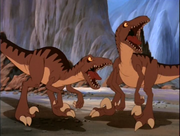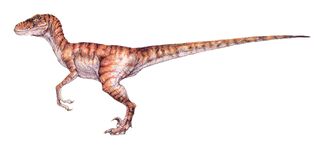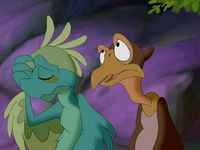Velociraptor [1] is a predatory dromaeosaur of the Cretaceous, about 75–71 million years ago. Velociraptor belonged to a group of dinosaurs called dromaeosaurs. In The Land Before Time series, dromaeosaurs are referred to as Fast Biters due to the fact that dromaeosaurs like Deinonychus, Velociraptor and Utahraptor rely on their speed and sharp teeth, including their sickle-like claws, to attack their prey.
Smaller than other dromaeosaurids like Deinonychus and Achillobator, Velociraptor still shared a number of the same anatomical features. It was a bipedal, feathered carnivore with a long, stiff tail and a large sickle-shaped claw on each foot, which is thought to have been used to kill its prey. Velociraptor can be told apart from other dromaeosaurids by its long and low skull, with an upturned snout, this feature is mainly seen in larger tyrannosaurids.

Velociraptors
Description
A Velociraptor is a small-sized dromaeosaurid that ran about 65 mph, reached up to 6.8 ft long, 1.6 ft high at the hip, and weighed about 15-33 lbs.[2] The skull, which grew up to 9.8 in long, was uniquely up-curved, concave on the top surface and convex on the lower. The jaws were lined with 26–28 widely spaced teeth on each side, each more strongly serrated on the back edge than the front—possibly an skill that helped it catch and hold fast-moving prey.[3][4]

Raptors

Fast Biters
Velociraptor, like other dromaeosaurids, had a large hand with 3 curved claws, which were similar in construction and flexibility to the wing bones of birds. The 2nd digit was the longest of the 3, while the 1st was shortest. The structure of the wrist bones prevented pronation of the wrist and forced the 'hands' to be held with the palm faced in, not down.[5] The 1st toe of the foot, as in other theropods, was a small dewclaw. Unlike most theropods, which had feet with 3 toes touching the ground, dromaeosaurids like Velociraptor walked on just their 3rd and 4th toes. The 2nd digit, for which Velociraptor is famed, was highly modified and held retracted off of the ground. It bore a large, sickle-shaped claw, typical of dromaeosaurid and troodontid dinosaurs. This large claw, which could be over 2.6 in long around its outer edge, was most likely a hunting tool used to tear into prey, possibly causing a fatal blow.
The tail of Velociraptor was stiff, with long bony projections on top of the vertebrae, as well as ossified tendons under it. The projections began on the 10th tail vertebra and spread forth to brace 4 to 10 more vertebrae, depending on position in the tail. The stiffness forced the whole tail to act as a rod-like unit, preventing vertical motion between vertebrae. Yet, at least one specimen preserves a set of intact tail vertebrae curved in an S-shape, suggesting that there was really more horizontal flexibility. These adaptations of the tail may have brought balance and stability while turning, especially at high speeds.[6][7] In 2007, paleontologists reported the discovery of quill knobs on a well-preserved Velociraptor mongoliensis forearm from Mongolia, confirming the presence of feathers in this species.[8]
History
On an American Museum of Natural History expedition to the Gobi Desert ( Mongolia ), in 1923, Peter Kaisen recovered the first Velociraptor fossil known: a crushed but complete skull, associated with one of the 2nd toe claws for hunting. The next year, museum chief Henry Fairfield Osborn mentioned the animal in a press article, under the name "Ovoraptor mongoliensis". However, as the name "Ovoraptor" had not been published in a scientific journal or accompanied by a description in good and due form, it remained a nomen nudum (a "naked name") and the name "Velociraptor" took priority. Later that year, Osborn designated the skull and claw (which he thought came from the hand) as belonging to a new genus, Velociraptor. This name is derived from the Latin words velox ("swift") and raptor ("thief" or "robber") and refers to the animal's fast nature and its meat diet. Osborn named the type species V. mongoliensis from the country it had been found.[9] [10]
During the Cold War , Mongolia was closed to North American teams but the expeditions led by Soviet and Polish scientists, in collaboration with Mongolian colleagues, found several more fossils of Velociraptor. The best known is part of the legendary "Fighting dinosaurs" discovered by a Polish-Mongolian team in 1971. The fossil preserves a Velociraptor in the midst of a fight against a lone Protoceratops .[11][12][13]

JP franchise Raptor,which inspired the ones seen in LBT
Between 1988 and 1990 , a joint Chinese-Canadian team discovered Velociraptor remains in north China.[14] US-Mongolian expeditions to the Gobi Desert, led by the American Museum of Natural History and the Mongolian Academy of Sciences, turned up new well-preserved skeletons between 1990 and 1995 .[15][16]
Classification
Velociraptor is a member of the subfamily Velociraptorinae, a sub-group of the family Dromaeosauridae. In phylogenetic taxonomy, Velociraptorinae is for the most part defined as "all dromaeosaurs more closely related to Velociraptor than to Dromaeosaurus." Dromaeosaurid classification is highly variable. Originally, the subfamily Velociraptorinae was made just to contain Velociraptor.[17] Other studies have included other genera, usually Deinonychus and Saurornitholestes.[18] A cladistic study said a monophyletic Velociraptorinae holding Velociraptor, Deinonychus, Tsaagan, and a closely related (but doubtfully placed) Saurornitholestes.[19]
In the past, other dromaeosaurid species, such as Deinonychus antirrhopus and Saurornitholestes langstoni, at times have been classified in the genus Velociraptor. Since Velociraptor was the first to be named, these species are now named Velociraptor antirrhopus and V. langstoni,[20] but, today the only recognized species of Velociraptor are V. mongoliensis [21][22][23] and V. osmolskae.[24]
When first described in 1924, Velociraptor was placed in the family Megalosauridae, as was the case with most carnivores at the time (Megalosauridae, like Megalosaurus, functioned as a sort of 'wastebin' taxon, where many unrelated species were grouped together).[25] As dinosaur discoveries multiplied, Velociraptor was later approved as a dromaeosaurid. All dromaeosaurids have also been referred to the family Archaeopterygidae by at least one author (which would, in effect, make Velociraptor a flightless bird) [26]
Paleobiology
Predatory behavior
They might have hunted in packs, but it's uncertain for the Velociraptor and the other dromaeosaurs evidence for pack hunting behavior has only been found for Deinonychus. Despite the lack of evidence for Velociraptor in particular predating in groups, there is substantial evidence that Velociraptor did prey upon Protoceratops, a horned dinosaur that was related to the Triceratops. The small ceratopsian lived in Asia along with other small ceratopsians like Udanoceratops, Bagaceratops, Yamaceratops, Helioceratops and Asiaceratops. The conclusion of the predator/prey relationship between Velociraptor and Protoceratops comes from a discovery made in 1971, wherein scientists found a very well preserved fossil of a Velociraptor locked in combat with a Protoceratops. The fossil showed a Protoceratops biting the arm of the Velociraptor, and the Velociraptor using its sickle-claw and pierce into the Protoceratops' throat. In the end, however, both of the dinosaurs ultimately met their end when a sandslide killed the two dinosaurs, and their bodies were left in the ground.
Feathers
In September 2007, researchers found quill knobs on the forearm of a Velociraptor found in Mongolia. These bumps on bird wing bones show where feathers anchor, and their presence on Velociraptor indicate it too had feathers.[27] Turner and colleagues interpreted the presence of feathers on Velociraptor as evidence that the ancestors of dromaeosaurids could fly, making Velociraptor and other large members of this family secondarily flightless. This idea has since been discarded; the unmodified forearms count against it. Therefore, the feathers in the ancestors of Velociraptor had another function. The feathers of the flightless Velociraptor may have been used for display, for covering their nests while brooding.[28]
Velociraptor in The Land Before Time

A close-up of the Velociraptor's toe-claw.

| This page (or section) is ridden with issues. Improvements would be highly appreciated. Additional information: Primarily issues with grammar and formatting. |
There were four Velociraptors. They appeared and attacked in The Land Before Time III: The Time of the Great Giving". The very first one was sighted by Mutt and pointed (When Hyp and Nod look up) and he shouts "That!" and the Raptor was on the edge of a cliff did a [Vicious Growling] at them. After it was sighted, Mutt sighted another one shouts "And that !" Two more have appeared on cliffs, one roared caused LittleFoot and his friends gasp, on the battle the Raptors were hunting in packs, one attacked almost bite Grandpa Longneck's neck got hit by his tail, landed on top of Mr. Three Horns' head tossed the dromaeosaur in the air and hits a cliff, falls down causing a rockslide to commence, after it's first attack, it roared at them till a big rock landed on top of its head (It was never seen again), now only three Velociraptors remaining continued the fighting. The trio then raced to going after the children and Hyp's Father. As Hyp's father and the children run to get help, they suddenly they hear the raptors snarling, they soon appeared on top of an edge of a cliff snarling at them, until Littlefoot's Grandpa and the others were able to stop them till they distract them and fighting them till Hyp says "Something bad is happening up there". Till the rumbling starts the cliff starts a rock slide, The raptors and the grown-ups fell down, felling into a coma after the fall, the raptors manage to recover from the fall, Hyp's Father manage to distract the raptors from the group, Hyp manage to go to distract them from attacking his father and now the raptors charged and attack Hyp, the raptors were got whip by Grandpa's tail, till the others recovered from the fall growling at them (Hyp's Father joins in). The raptors followed Hyp up a pile of rocks (Hyp's foot accidently knocks down one) hits one till the other two head up till the other got tossed in the air by Cera's Dad while he's charging at it. Littlefoot and his friends (plus Hyp, Mutt and Nod) manage to knock down a big one,(unblock the water) while the attack is still continuing the pack about to attack all together. The water was about break open till Grandpa longneck shouts "Run!" the raptors noticed the dam of rocks of the water is about to explode finally the dam breaks the raptors were in the water (they can't swim), The water made it all the way to the Great Valley puts out the fire finally, the raptors last be seen on land at the opposite of the bank till one roars out at the group (the screen pans to the right, still can hear the raptor roaring).
Trivia
- The Velociraptor seen in The Land Before Time III: The Time of the Great Giving were one of the few antagonists to survive the events of the film. Some others included a Liopleurodon from The Land Before Time IX: Journey to Big Water, a group of Tyrannosaurus in The Land Before Time X: The Great Longneck Migration, and Yutyrannus pair and a Carnotaurus in The Land Before Time XIV: Journey of the Brave.
- It can be noted that the Velociraptor seen in the third Land Before Time are almost identical in appearance to the Deinonychus dubbed Velociraptor seen in the films, Jurassic Park and The Lost World: Jurassic Park. This is mainly because Jurassic Park had been out for a couple of years before the release of the third Land Before Time film, and by that time Velociraptor had already gained a international sweep of fame from its debut film.
- Velociraptor technically wasn't the first Fast Biter to appear within the Land Before Time franchise, with this credit going to Dromaeosaurus and Ornitholestes.
Gallery
References
- ↑ Velociraptor = 'swift robber', sometimes called 'raptor' for short.
- ↑ Paul, Gregory S. (1988). Predatory Dinosaurs of the World. New York: Simon and Schuster. pp. 464pp. ISBN 978-0-6716-1946-6.
- ↑ Osborn, Henry F. (1924a). "Three new Theropoda, Protoceratops zone, central Mongolia". American Museum Novitates 144: 1–12.
- ↑ Barsbold, Rinchen; Osmólska, Halszka (1999). "The skull of Velociraptor (Theropoda) from the Late Cretaceous of Mongolia". Acta Palaeontologica Polonica 44 (2): 189–219.
- ↑ Paul, Gregory S. (2002). Dinosaurs of the Air: The Evolution and Loss of Flight in Dinosaurs and Birds. Baltimore: Johns Hopkins University Press. ISBN 978-0801867637.
- ↑ Barsbold, Rinchen (1983). "Carnivorous dinosaurs from the Cretaceous of Mongolia". Transactions of the Joint Soviet-Mongolian Paleontological Expedition 19: 5–119.
- ↑ Norell, Mark A.; Makovicky, Peter J. (1999). "Important features of the dromaeosaurid skeleton II: information from newly collected specimens of Velociraptor mongoliensis". American Museum Novitates 3282: 1–45.
- ↑ Turner, A.H.; Makovicky, P.J.; Norell, M.A. (2007). "Feather quill knobs in the dinosaur Velociraptor". Science 317 (5845): 1721. doi:10.1126/science.1145076. PMID 17885130.
- ↑ Osborn, Henry F. (1924a). "Three new Theropoda, Protoceratops zone, central Mongolia". American Museum Novitates 144: 1–12.
- ↑ Osborn, Henry F. (1924b). "The discovery of an unknown continent". Natural History 24: 133–149.
- ↑ Barsbold, Rinchen (1983). "Carnivorous dinosaurs from the Cretaceous of Mongolia". Transactions of the Joint Soviet-Mongolian Paleontological Expedition 19: 5–119.
- ↑ Kielan-Jaworowska, Zofia; Barsbold, Rinchen (1972). "Narrative of the Polish-Mongolian Paleontological Expeditions". Paleontologica Polonica 27: 5–13.
- ↑ Barsbold, Rinchen (1974). "Saurornithoididae, a new family of theropod dinosaurs from Central Asia and North America". Paleontologica Polonica 30: 5–22.
- ↑ Jerzykiewicz, Tomasz; Currie, Philip J.; Eberth, David A.; Johnston, P.A.; Koster, E.H.; Zheng, J.-J. (1993). "Djadokhta Formation correlative strata in Chinese Inner Mongolia: an overview of the stratigraphy, sedimentary geology, and paleontology and comparisons with the type locality in the pre-Altai Gobi". Canadian Journal of Earth Sciences 30 (10): 2180–2195. doi:10.1139/e93-190.
- ↑ Norell, Mark A.; Makovicky, Peter J. (1999). "Important features of the dromaeosaurid skeleton II: information from newly collected specimens of Velociraptor mongoliensis". American Museum Novitates 3282: 1–45.
- ↑ Norell, Mark A.; Makovicky, Peter J. (1997). "Important features of the dromaeosaur skeleton: information from a new specimen". American Museum Novitates 3215: 1–28.
- ↑ Barsbold, Rinchen (1983). "Carnivorous dinosaurs from the Cretaceous of Mongolia". Transactions of the Joint Soviet-Mongolian Paleontological Expedition 19: 5–119.
- ↑ Currie, Philip J. (1995). "New information on the anatomy and relationships of Dromaeosaurus albertensis (Dinosauria: Theropoda)". Journal of Vertebrate Paleontology 15 (3): 576–591. doi:10.1080/02724634.1995.10011250.
- ↑ Norell, Mark A.; Clark, James M.; Turner, Alan H.; Makovicky, Peter J.; Barsbold, Rinchen; Rowe, Timothy (2006). "A new dromaeosaurid theropod from Ukhaa Tolgod (Omnogov, Mongolia)". American Museum Novitates 3545: 1–51. doi:10.1206/0003-0082(2006)3545[1:ANDTFU]2.0.CO;2.
- ↑ Paul, Gregory S. (1988). Predatory Dinosaurs of the World. New York: Simon and Schuster. pp. 464pp. ISBN 978-0-6716-1946-6.
- ↑ Barsbold, Rinchen; Osmólska, Halszka (1999). "The skull of Velociraptor (Theropoda) from the Late Cretaceous of Mongolia". Acta Palaeontologica Polonica '44' (2): 189–219.
- ↑ Paul, Gregory S. (2002). Dinosaurs of the Air: The Evolution and Loss of Flight in Dinosaurs and Birds. Baltimore: Johns Hopkins University Press. ISBN 978-0801867637.
- ↑ Norell, Mark A.; Makovicky, Peter J. (2004). "Dromaeosauridae". In Weishampel, David B., Dodson, Peter & Osmólska, Halszka (eds.). The Dinosauria (Second ed.). Berkeley: University of California Press. pp. 196–209. ISBN 0-520-24209-2.
- ↑ Godefroit, Pascal; Currie, Philip J.; Li, Hong; Shang, Chang Yong; Dong, Zhi-ming (2008). "A new species of Velociraptor (Dinosauria: Dromaeosauridae) from the Upper Cretaceous of northern China". Journal of Vertebrate Paleontology 28 (2): 432–438. doi:10.1671/0272-4634(2008)28[432:ANSOVD]2.0.CO;2.
- ↑ Osborn, Henry F. (1924a). "Three new Theropoda, Protoceratops zone, central Mongolia". American Museum Novitates 144: 1–12.
- ↑ Paul, Gregory S. (2002). Dinosaurs of the Air: The Evolution and Loss of Flight in Dinosaurs and Birds. Baltimore: Johns Hopkins University Press. ISBN 978-0801867637.
- ↑ Turner A.H.; Makovicky P.J.; Norell M.A. 2007. Feather quill knobs in the dinosaur Velociraptor. Science 317: 1721. PMID 17885130.
- ↑ Milner, Angela 2002. Dinobirds: from dinosaurs to birds. Natural History Museum, London.
External links
- American Museum of Natural History. "Fighting Dinosaurs: New Discoveries from Mongolia: Videos." c.2000. Three videos related to a fight between Protoceratops and Velociraptor.
- Hartman, Scott. "Velociraptor." SkeletalDrawing.com. Several artistic renditions of Velociraptor.




